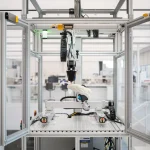Over the past decade, information has been generated and utilized at an unprecedented scale across all verticals, and architecture is no different. This big data explosion, starting in 2010 and ending in 2020, has bettered architects’ approach to designing and constructing more efficient, sustainable, and user-centric spaces.
According to Google, “Big data describes large and diverse datasets that are huge in volume and also rapidly grow in size over time. Big data is used in machine learning, predictive modeling, and other advanced analytics to solve business problems and make informed decisions.”
With integrated parametric design tools, architects can now harness such a wealth of information and turn raw data into insightful solutions. This article will look at how big data fuels these parameter optimizations in architecture and shapes up the built environment.
Understanding Big Data in Architecture
Big data refers to large volumes of structured and unstructured data emanating from various sources such as social media, sensors, building information modeling (BIM), and environmental data. Large sections of the architectural profession are beginning to make use of this resource by leveraging insights gained from data analytics for the purposes of design decision-making.
The data-driven design pushes architects beyond intuition and experience into a realm where informed choices may be founded upon quantitative evidence. For instance, usage patterns, user preference data, and environmental data will allow the architect to better optimize design for enhanced occupant satisfaction.
The ability to analyze data in both historic and real-time formats is another important big data capability that exists in architectural integration. Historical data will reveal trends and patterns, whereas real-time data allows architects to tweak the designs in relation to current conditions. For example, when designing a public park, architects can take inspiration from information on pedestrian flow and sunlight to best determine the placement of walkways and other landscaping features to make the space more enjoyable and usable.
To learn more about Big Data in architecture, parametric optimization, and its tools, check out the “Parametric Optimizations: Decoding Spaces and Places” workshop, which focuses on managing design data and optimizing projects for sustainability and performance using Ladybug and LunchBox.
The Role of Parametric Design Tools
The aspect of parametric design includes the architect in a computational design process by allowing them to define relationships between several design elements and parameters. Under this methodology, designers can explore a variety of design iterations in relatively quick adaptation as changing inputs and constraints unfold.
Tools like Grasshopper 3D, integrated with Rhinoceros, are emerging as the most critical platforms for architects who want to use Big Data in their design processes.
With the integration of parametric design, architects can create algorithms that dynamically respond to the input of data; this therefore allows designers to optimize design results in real time. In such a case, architects are able to analyze and optimize their designs on sustainability and performance using such plugins as Ladybug and Galapagos.
Ladybug is a free environmental analysis plug-in that enables designers and architects to assess solar radiation, wind patterns, thermal comfort, and others within the conceptual design phase. By applying data through the Ladybug plugin, designers are enabled to see the vision of how their designs will perform under various environmental conditions, thus making informed decisions related to orientation, materials, and shading.
Galapagos is a genetic algorithm tool that aims to optimize the design parameters of something by emulating the processes of evolution. By using various goals, such as maximizing daylight access or minimizing energy use, Galapagos can iterate automatically through thousands of variations in design and return the most efficient solution. In this way, it automates some optimization processes that architects would have had to do through tedious calculations, allowing them to be more creative and innovative.
Real-World Applications and Case Studies
Big Data and parametric optimizations are now more practical with every passing day through the cases and projects prepared on them in architecture. One different case is the Bosco Verticale, or Vertical Forest, in Milan, Italy. This complex of revolutionary residential apartments hosts thousands of trees and plants on its façade that contribute to increasing biodiversity and air quality.
Designers informally integrated environmental data to understand the contribution of vegetation to improving the energy efficiency of, and comfort for, occupants inside the building. The plants and their placement were optimized in a parametric design process to amplify positive factors but still retain aesthetic appeal in the building. Integrating big data into the design process enhanced its sustainability and iconic status across the urban landscape.
Another very representative example is the Edge, Amsterdam, which is an office building that is often claimed to be the greenest in the world. The Edge uses a comprehensive set of sensors for occupancy, temperature, and lighting to adjust in real time to optimize comfort and efficiency. The architects have used the help of parametric design tools to make an adaptable workspace responding to its users. By mining data from the sensors, the design team was able to optimise the layout, environmental systems, achieve remarkable energy savings, and improve occupant satisfaction.
Of course, the integration of Big Data and parametric optimizations is bound to play the leading role in how the architectural profession is going to continue changing in the future. This ability enables architects to design spaces that are functional, sustainable, and, most importantly, aesthetically pleasing.
In the future, architects will have to learn from these technological changes and accept them; they will also have to update their knowledge constantly to keep up with such issues. Big Data and parametric design tools can help architects go through a more conscious approach to design, centered on user experience, environmental responsibility, and innovative problem-solving.


























Leave a comment